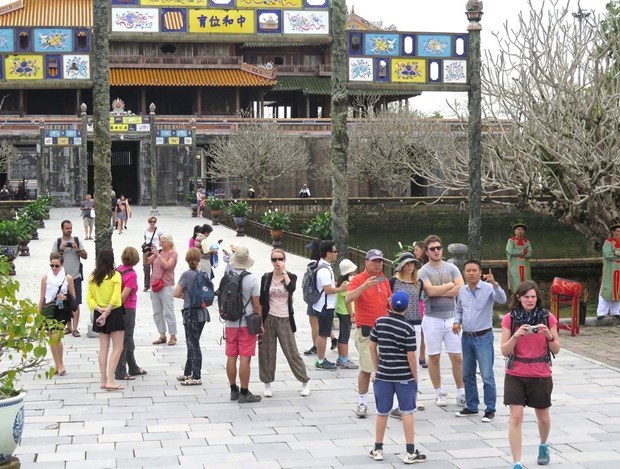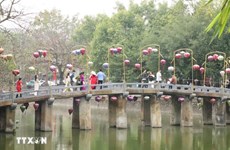Thua Thien-Hue works to tap tourism potential
 Visitors to Thua Thien- Hue province (Photo: VNA)
Visitors to Thua Thien- Hue province (Photo: VNA)
Thua Thien – Hue (VNA) – Bestowed with many UNESCO tangible and intangible heritages, the central province of Thua Thien-Hue has huge potential to develop tourism.
According to the Hue Monuments Conservation Centre, from the outset of the year, the province has welcomed 2.6 million visitors, which lags behind its position as a large tourism hub in the country.
Meanwhile, the Vietnam National Administration of Tourism said that international visitors to the locality are just one third of tourists to Hanoi, one fourth of holidaymakers to Ho Chi Minh City, and only 70 percent of those who travel to Da Nang and Khanh Hoa.
Treasure of heritages
Hue, the formal imperial capital of Vietnam for hundreds of years, is home to five heritages recognised by UNESCO, including the ancient citadel relic complex (a World Cultural Heritage site), Hue royal court music (an intangible cultural heritage), Nguyen Dynasty’s wood blocks (a documentary heritage), Nguyen Dynasty’s royal administrative documents (part of the Asia-Pacific Register of UNESCO’s Memory of the World Programme), and literature on Hue royal architecture (another documentary heritage).
The Hue Monuments Complex was designed to be in harmony with the natural setting of the site and was aligned cosmologically with the five cardinal points (centre, west, east, north, and south), the five elements (earth, metal, wood, water, and fire), and the five colours (yellow, white, blue, black, and red), according to a tour guide.
The central structure is the citadel area, which was the administrative and military centre of southern Vietnam during the 17th and 18th centuries.
Further upstream of the Huong (Perfume) River are the tombs of the Nguyen Dynasty’s kings, which are popular sites for tourists.
Ngu Binh Mountain and the Perfume River that runs through the city give the feudal capital great natural beauty and help define its symbolic importance.
The complex site was chosen for its natural features that include hills that act as a protective screen in front of the monuments and prevent the entry of malevolent spirits.
Within this landscape, the main features of the city are laid out.
It is a remarkable example of the planning and construction of a completely defended capital within a relatively short period in the early 19th century, according to experts. The integrity of the town layout and building design make it an exceptional specimen of late feudal urban planning in East Asia.
However, the complex site has been affected by wars as well as modern urbanisation. Nevertheless, it remains fairly well preserved, with its overall integrity maintained.
Surrounding the central area of the complex are other monuments of importance that include ritual sites related to the spiritual life of the dynasty, such as Van Mieu (Temple of Literature), Dan Nam Giao (Esplanade of Sacrifice to the Heaven and Earth), Ho Quyen (Royal Area), and Dien Voi Re (Shrine of the Roaring Elephant).
And outside the complex of monuments in another part of Hue is the oldest pagoda in the city, Thien Mu Pagoda (Pagoda of the Celestial Lady), built in 1601, and associated with many legends.
Sustainable tourism development
Thua Thien-Hue is planning to become a cultural, tourism and health care centre in Southeast Asia by 2020. Therefore, it will work out new initiatives to promote values of local cultural heritages, develop tourism in a sustainable manner and boost economic growth.
Earlier this year, the local authorities began an ambitious project to rebuild a destroyed palace inside the Imperial Citadel.
Kien Trung Palace, which was built between 1921 and 1923 during the reign of Emperor Khai Dinh, once served as the living and working space of Bao Dai, the last king of the Nguyen Dynasty, which ruled the country from 1802 until the end of the feudal era in 1945.
It incorporated elements from three distinct architectural styles, traditional Vietnamese, French and Italian Renaissance, to embody an era of western influence in Vietnam.
However, it was destroyed in the late 1940s during the first Indochina War (1946-1954), with only its foundation remaining intact.
According to the Hue Monuments Conservation Centre, the work is expected to cost 123 billion VND (5.3 million USD) and be finished in 2022.
The reconstruction reflects local authorities’ continued efforts to conserve the Imperial Citadel, a popular tourist attraction in central Vietnam, as part of an effort to boost tourism.
Besides, the tourism sector has worked to promote the project “Hue – the food hub” while encouraging smart eco-tourism projects to meet increasing demands of tourists and develop local tourism.
Along with focusing on key and potential markets, the province also enhances investment attraction in strategic tourism projects, aiming to develop tourism as its spearhead economic sector.
This year, the province aims to attract about 4.7 million visitors with 45 percent being foreigners, a rise of about 7 percent year on year.
The province, owning many UNESCO-recognised tangible and intangible heritage as well as beautiful beaches, targets 4.9 trillion VND (210.7 million USD) in tourism revenue in the year, up 10 percent compared to the previous year.
 This year, the province aims to attract about 4.7 million visitors with 45 percent being foreigners, a rise of about 7 percent year on year. (Photo: VNA)
This year, the province aims to attract about 4.7 million visitors with 45 percent being foreigners, a rise of about 7 percent year on year. (Photo: VNA)
Last year, Thua Thien-Hue welcomed more than 4.3 million visitors, a rise of 14 percent, with the number of foreign visitors rising 30 percent. Tourism revenue reached 4.47 trillion VND, up 27.1 percent compared to 2017. Notably, Thua Thien-Hue was chosen as one of the most attractive destinations of Vietnam.
The leading market of the provincial tourism was the Republic of Korea with 29.3 percent of market share, followed by France with 9 percent, Thailand with 6.6 percent and Germany 5.3 percent.
In the year, Thua Thien-Hue also greeted 134,100 tourists aboard 54 cruise ships, a rise of 5 percent year on year.-VNA












